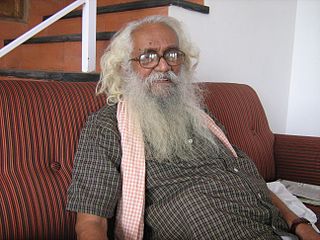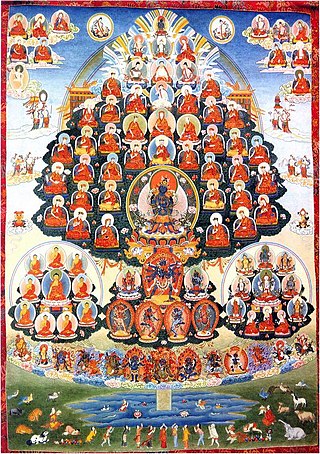
Inedia or breatharianism is the claimed ability for a person to live without consuming food, and in some cases water. It is a deadly pseudoscientific practice, and several adherents of these practices have died from starvation or dehydration.

Tibetan Buddhism is a form of Buddhism practiced in Tibet, Bhutan and Mongolia. It also has a sizable number of adherents in the areas surrounding the Himalayas, including the Indian regions of Ladakh, Sikkim, and Arunachal Pradesh, as well as in Nepal. Smaller groups of practitioners can be found in Central Asia, Xinjiang, Inner Mongolia, and some regions of Russia, such as Tuva, Buryatia, and Kalmykia.

Tantra is an esoteric yogic tradition that developed on the Indian subcontinent from the middle of the 1st millennium CE onwards in both Hinduism and Buddhism.

Vajrayāna, also known as Mantrayāna, Mantranāya, Guhyamantrayāna, Tantrayāna, Tantric Buddhism, and Esoteric Buddhism, is a Buddhist tradition of tantric practice that developed in the Indian subcontinent and spread to Tibet, Nepal, other Himalayan states, East Asia, and Mongolia.

Basava Premanand was an Indian skeptic and rationalist from Kerala, India. He organised many tours around rural India for the promotion of scientific thinking, exposing alleged miracles and scams carried out by various charlatans and godmen while spreading awareness of dangerous superstitions. Premanand was the founder of the Federation of Indian Rationalist Associations, the convener of Indian CSICOP, and the owner-publisher-editor of the monthly magazine The Indian Skeptic, which investigates paranormal claims in India.

Abraham Thomas Kovoor was an Indian professor and rationalist who gained prominence after retirement for his campaign to expose as frauds various Indian and Sri Lankan "god-men" and so-called paranormal phenomena. His direct, trenchant criticism of spiritual frauds and organized religions was enthusiastically received by audiences, initiating a new dynamism in the Rationalist movement, especially in Sri Lanka and India.

Kamakhya, a mother goddess, is a Shakta Tantric deity; considered to be the embodiment of Kama (desire), she is regarded as the goddess of desire. Her abode–Kamakhya Temple is located in the Kamarupa region of Assam, India. Originally a Kirata goddess, Kamakhya remained outside Brahmanical influence until at least 7th century CE. Residing on Nilachal hills across the banks of the Brahmaputra river, west of Guwahati in the 10th/11th century Temple rebuilt in 1565 CE, she is worshiped in a non-iconic and un-anthropomorphic form of stone shaped like yoni fed by a perennial stream. The temple is primary amongst the 51 Shakti Pithas, and is one of the most important Shakta temples.
Prahlad Jani, also known as Mataji or Chunriwala Mataji was an Indian breatharian monk who claimed to have lived without food and water since 1940. He said that the goddess Amba sustained him. However, the findings of the investigations on him have been kept confidential and viewed with skepticism. He made several media and public appearances.
Joseph Edamaruku, popularly identified by his surname Edamaruku, was a journalist and rationalist from Kerala. He was the Delhi Bureau chief of the Malayalam magazine Keralasabdam for more than twenty years, and the founder-editor of Therali, a rationalist periodical in Malayalam. He was president of the Indian Rationalist Association from 1995 to 2005.

Sanal Edamaruku is an Indian author and rationalist. He is the founder-president and editor of Rationalist International, the president of the Indian Rationalist Association and the author of 25 books and other articles. In 2012, after examining an alleged miracle at a local church in Mumbai, he was charged under India's blasphemy law, causing him to voluntarily exile to Finland.
The Indian Rationalist Association is a voluntary organisation in India whose 100,000 members promote scientific skepticism and critique supernatural claims. It publishes books and magazines, organises seminars and lectures and its representatives regularly appear in television and print media exposing superstitions. The present president of Indian Rationalist Association Sanal Edamaruku was elected in 2005. He was the General Secretary of the association from 1984 till 2005.

In Vajrayana, guru yoga is a tantric devotional practice in which the practitioner unites their mindstream with the mindstream of the body, speech, and mind of their guru. Guru yoga is akin to deity yoga since the guru is visualized in the same manner as with a meditational deity. The process of guru yoga may entail visualization of a refuge tree as an invocation of the lineage, with the 'root guru' channeling the blessings of the entire lineage to the practitioner. The guru may be visualized as above the meditator, in front of them, or in their heart. Guru yoga may also include a liturgy, prayer, or mantra, such as the "Seven Line Prayer" of Padmasambhava, or the "Migtsema".
Lamdré is a meditative system in Tibetan Buddhism rooted in the view that the result of its practice is contained within the path. The name "lamdré" means the “path" with its fruit Wylie: ‘bras). In Tibet, the lamdré teachings are considered the summum bonum of the Sakya school.

Kali or Kalika is a major Hindu goddess associated with time, change, creation, power, destruction and death in Shaktism. Kali is the first of the ten Mahavidyas in the Hindu tantric tradition.
Superstition refers to any belief or practice that is caused by supernatural causality, and which contradicts modern science. Superstitious beliefs and practices often vary from one person to another or from one culture to another.
Shava sadhana is a Tantric sadhana in which the practitioner sits on a corpse for meditation. Shava sadhana is part of the vamachara ('heterodox') practice of worship, which is followed by the esoteric Tantra.

Brahmarakshas is an Indian Hindi-language supernatural thriller television series broadcast on Zee TV and digitally available on ZEE5. Spanning two seasons, it is a franchise produced by Ekta Kapoor under her studio Balaji Telefilms.

Tantra (Black Magic) is an Indian Hindi language supernatural television series based on black magic which aired from 3 December 2018 to 5 April 2019 on Colors TV. Produced by Siddharth Kumar Tewary under Swastik Productions, it starred Sargun Kaur Luthra, Juhi Parmar, Manish Goel, Gautam Singh Vig and Sameksha.

Virupa, also known as Virupaksa and Tutop Wangchuk, was an 8th-9th century Indian mahasiddha and yogi, and the source of important cycles of teachings in tantric Buddhism.
The Weeping crucifix in Mumbai is a statue of the crucified Jesus in Mumbai which attracted widespread attention in 2012 when a constant stream of water began to seep from its feet. Some of the local Catholic faithful believed the incident to be a miracle; however, the skeptic-rationalist author Sanal Edamaruku provided evidence that the water stemmed from a faulty sewage system, which seeped due to capillary action. However, Edamaruku also accused Latin Christian priests of regularly scamming devotees and defrauding miracles to make money, and build bigger and newer churches or convents, and mocked the Pope as "anti-science". A church representative admitted Edamaruku had the "right to doubt", and Christian activists said that the backlash was not for debunking the alleged "miracle" but for the defamatory statements made live on television. After which he became subsequently subject to multiple first information reports (FIR) under blasphemy laws. A Catholic lawyer and the Roman Catholic Archdiocese of Bombay called for him to apologise for the comments. After receiving a barrage of threats, he migrated to Finland to avoid being arrested under the blasphemy law.













